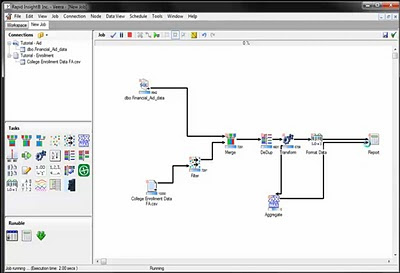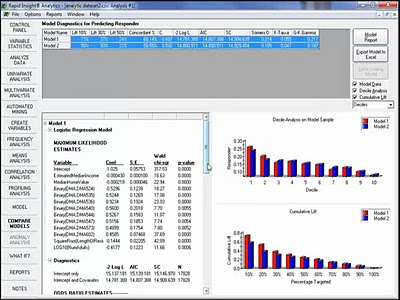Predictive modeling is widely used by consumer marketers to select names for mailing lists and to decide which products to offer existing customers. These models are typically built by statisticians with tools like SAS and SPSS. In other cases, marketers can build them for themselves with automated tools like KXEN that are tightly integrated with the marketing automation system.
But most marketers still don’t have a marketing automation system or even an integrated marketing database. Nor do they have the skills to use a product like SAS. This group needs stand-alone tools to do two key things: assemble data from multiple sources, and build and execute the models themselves. (Okay, three things.)
Rapid Insight offers exactly those two (or three) capabilities in a reasonably priced package.
Veera is the data assembly tool. It lets users connect to most standard data sources and then define a processing flow to filter, merge, aggregate, transform and otherwise manhandle data into a form that makes it useful. Veera also provides some basic analytics including descriptive statistics (mean, median, value frequencies, etc.), cross tabs and graphing. The flow is set up as a sequence of icons with a drag-and-drop interface, which means users don’t have to learn a scripting language. Rather than go into more details, I'll just point you to the vendor's on-demand demo.

The predictive modeling tool, prosaically named Analytics, builds logistic and least squares regression models. (Logistic models predict yes/no outcomes such as whether someone will respond to a promotion; least squares models predict continuous numeric outcomes such as lifetime value.) The Analytics interface is more sequential than Veera: users get a set of tabs that lead them through the steps of loading data, selecting variables, building the model itself, assessing the results, and scoring an audience. At each step along the way, users can make their own decisions or allow the system to choose for them.
I’ve seen quite a few automated modeling systems over the years, and was impressed at how well Analytics provides users with information to understand what's happening and take control when desired. This should let the system satisfy knowledgeable statisticians looking for a productivity enhancer, as well as novices who want to rely on the system's choices. Analytics also has a good online demo.

Veera and Analytics both run in client/server or desktop configurations. They load data into system memory (RAM), which means very large projects could be problematic. The vendor says a half-million rows with a couple hundred variables is a reasonable universe to model.
The two products are sold separately. This makes sense: many companies could use a generic data assembly tool like Veera for purposes other than modeling. For example, marketers might use it to construct a multi-source marketing database for promotions or analytics.
Pricing is $3,000 for the first Veera user and $5,000 for Analytics, with discounts for additional licenses. This is quite reasonable compared with other automated modeling systems, although other products often provide more than just regression models. Annual maintenance for each product is $1,750 per license. Rapid Insights has been selling its products since 2005 and has more than 150 clients with over 200 licenses.


No comments:
Post a Comment